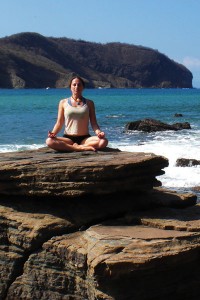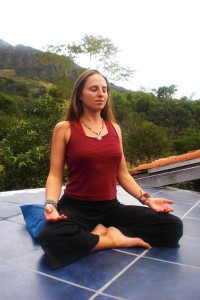 Breath is life, and it connects us to all that lives around us. This is why one of the main focuses of yoga is the breath, including the practice of pranayama.
Breath is life, and it connects us to all that lives around us. This is why one of the main focuses of yoga is the breath, including the practice of pranayama.
Can you recall the feeling of your breath really opening up in a yoga pose? Or the shifting of your mind and emotions into a state of peace when you pause and just turn your focus to your breath?
So much of yoga is about the breath, for breath is infused with prana, which is literally the energy of life. Here’s what my teacher, John Friend, has to say about prana in the Anusara® yoga Teacher’s Manual:
“Prana is the vital force in our bodies. It interpenetrates and pulsates within every cell – giving life to our body… Every particle of the physical body, every molecule of DNA, every cell, every organ, and every gland pulsates with prana.”
One of the practices of yoga is pranayama, which is often referred to as ‘breath control’, however I much prefer to consider it a ‘co-created dance’ with your breath.
To me, the concept of control calls in the hardened attitude of domination and separation with one being in control over another.
But we’re speaking of Nature in one of her most essential forms; the movement of life! For pranayama to bring joy and equanimity, doesn’t it make sense to deeply honour the relationship between yourself and your breath? And, when you think about it, where does the breath end and you begin?
In pranayama you are directing your breath to dance in specific ways and to move as you ask, yet because the breath contains the essence of life, this dance is one of great respect and care. When you honour your breath and your intention is to invite prana to create a state of harmony within you, the rewards of health and happiness are bountiful!
Whether you are dancing with the breath in a seated practice of pranayama, or flowing with your breath in an active asana practice on your mat, this attitude of co-participation allows you to stay humble and in remembrance that prana weaves a bigger energy into your life.
Your intention is so important when you do yoga, because this dance of breath manifests the feelings of your intention. For instance, if you are holding an attitude that is hardened, forced, angry, or fearful, when you do yoga or practice pranayama the prana gets agitated and it can worsen the difficulties you’re dealing with, even to the point of being harmful.
However, no matter what feelings you are experiencing when you start your practice, if you have the attitude that you are turning towards the light of illumination, intending to transform those feelings by opening to a bigger energy as you practice, then the breath will take you there.
As John Friend writes, “The breath interweaves the threads of one’s intention into the fibers of the outer body… Breath is the energetic essence of Action.”
Practicing Pranayama
 There are many types of pranayama, and it is best to dive into this practice led by your teacher, yet there are several general things to keep in mind.
There are many types of pranayama, and it is best to dive into this practice led by your teacher, yet there are several general things to keep in mind.
1. Always begin by simply observing your natural breath without any direction other than turning your focus to feel how the prana moves through your inhale and exhale. By first honouring the natural pulsation of your breath as it is, and opening to receive the breath as a gift of grace, you will be more in harmony when you begin different dance steps in the form of pranayama.
2. Just as in yoga, you never want to force or strain. If you feel your body tighten or resist when you’re doing pranayama, soften and allow your breath to lead, rather than your mind. If this softening doesn’t melt the tension, release the technique you were working with and simply return to watching the natural breath with the intention of being sensitive and sweet.
3. Your posture has influence over how your breath moves and how freely the prana can flow within you. If you are aligned in a beautiful seated position, optimal circulation carries the prana through your body and your experience is enhanced. If you are slumped, misaligned, or in pain, it obviously restricts the experience. This is why asana practice is such an integral part of yoga, because it helps you learn to align in ways that feel good and offer grace in the dance.
One of the best places to begin when learning pranayama is to practice Ujjayi breath. I’ve written a blog post with a guided video practice here: Ujjayi Yoga Breath.
If you’re familiar with Ujjayi pranayama and would like to take it a step further, one way is to expand the space between the inhale and exhale. For instance, if you are inhaling and exhaling to a count of 7, you could sweetly expand and retain the breath to a count of 7 before exhaling. I find this a beautiful practice that leads me into the sanctuary of subtle pulsation where mind, body, heart, and spirit can soar!
Mini-Meditation: The Space Between The Breath
As you read this, invite your posture to become more beautiful and spacious…
Receive your breath by simply expanding and letting it enter you more deeply and joyfully…
Isn’t it amazing how something that subtle can feel that good?
In this short practice, you are given the opportunity to observe the space between your breaths, and how entering into that awareness can shift your state in a profound way!
Mini-Meditation:
Sit beautifully, settling into your hips and lifting up through your spine.
Take a few moments to simply observe your natural breath, noticing how your ribs expand and your heart rides upon the rise and fall of your diaphragm.
Think of your breath as a gift you receive as you open from the inside, allowing its waves of life energy to cycle through your body and being.
Once you are more in tune with the natural pulsation of your breath, begin to pay particular attention to the space between each inhale and exhale.
You don’t need to direct your breath at all, but just by focusing on these gaps you may notice that they become broader and more accessible.
Continue to feel and watch the top of each inhale and the bottom of each exhale.
What effect does this have on your mind and emotions…
How does it feel physically to focus on these spaces of transition?
Ride the waves of your breath as long as you’d like, enjoying the spaces in between.
Whatever your practice of pranayama, may it be a blessing of joy and peace that leads you further into the heart where all things become one.
Do you have a certain pranayama practice that brings you delight? Please feel free to share it as a comment below! 🙂
